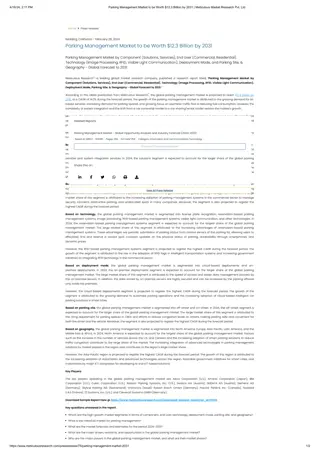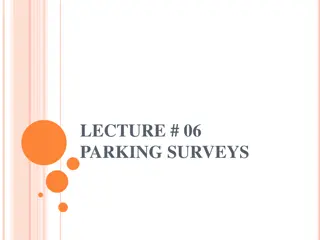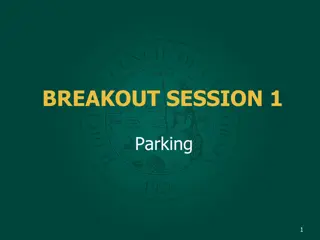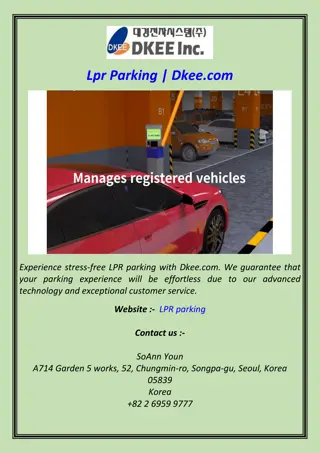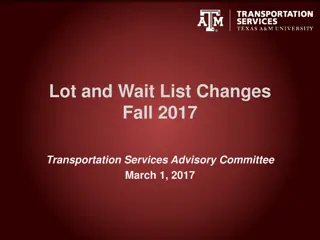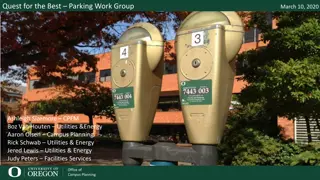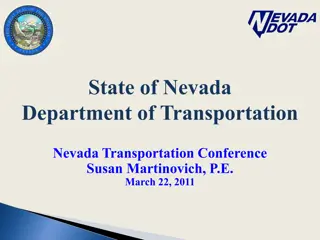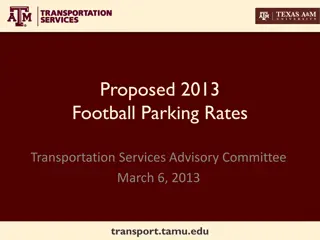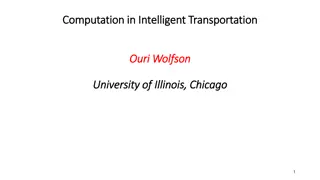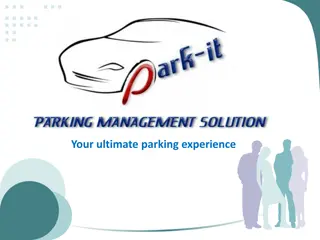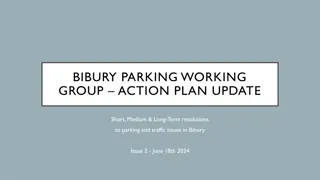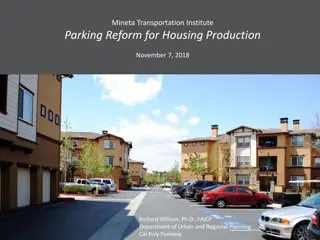Essential Elements of Highway Transportation: Parking Facilities
The necessity of parking facilities for vehicles on highways is highlighted in this lecture, emphasizing the importance of providing parking spaces in various areas such as residential, commercial, and shopping centers. It discusses on-street and off-street parking options, types of parking facilities, key definitions like space-hour and parking turnover, and factors like parking load and occupancy rate.
Download Presentation

Please find below an Image/Link to download the presentation.
The content on the website is provided AS IS for your information and personal use only. It may not be sold, licensed, or shared on other websites without obtaining consent from the author. Download presentation by click this link. If you encounter any issues during the download, it is possible that the publisher has removed the file from their server.
E N D
Presentation Transcript
3rdStage Lecture 9 Lecture. Dr. RanaAmir Yousif Lecture. Dr. SadyAbd Tayh Civil Engineering Al-Mustansiriyah University 2019-2020
References: Nicholas J. Garber and Lester A. Hoel. Traffic and Highway Engineering , Fourth Edition. Yoder; E. J. and M. W. Witczak, Principles of Pavement Design , A Wiley- Interscience Publication, John Wiley & Sons Inc., U.S.A., 1975. Yaug H. Huang, Pavement Analysis and Design , Prentic Hall Inc., U.S.A., 1993. AASHTO Guide for Design of Pavement Structures 1993 , AASHTO, American Association of State Highway and Transportation Officials, U.S.A., 1993. Oglesby Clarkson H., Highway Engineering , John Wiley & Sons Inc., U.S.A., 1975.
Any vehicle traveling on a highway will at one time or another be parked for either relatively shorter time or much longer time, depending on the reason of parking. The provision of parking facilities is therefore an essential element of the highway transportation. The need for parking spaces is usually in areas where land uses include: Residential, Commercial, Shopping centers, and Etc.
On-street parking (curb parking) Parking facilities can be divided Off-street parking
Off-street Parking: This facilities may be privately or publicly owned. Surface parking. Multistory garage. Under ground garage.
1. A space-hour: define the use of a single space for period of 1 hr. 2. Parking volume: total number of vehicles that park in a study area during specific length of the time, usually a day. 3. Parking accumulation: is the number of parked vehicles in a study area at any specific time.
4. The Parking Load: The area under the accumulation curve between two specific times. It is usually gives as the number of space-hours used during the specified period of time. 5. Parking duration: The length of time a vehicles is parked at a parking bay (minutes or hour). 6. Parking turnover: is the rate of use of a parking space and is obtained by dividing the parking volume for a specified period by the number of parking spaces
N TR = STs TR: Parking turnover rate (veh./space/hr). N: total number of vehicles parked. S: total number of parking spaces. Ts: duration of the study period(hr). 7. Occupancy: Proportion spaces utilized at any movement. Occupancy=Accumulation/total spaces
Solution: Calculate the space-hours of demand using Commuters now being served= 0.6*200*9=1080 space-hr. Shoppers now being served= 0.4*200*2=160 space-hr. Total number of vehicles turned away =(200/0.8)-200=50. Commuters not being served= 0.2*50*9=90 space-hr. Shoppers not being served= 0.8*50*2=80 space-hr
Total space-hrs of demand =(1080+160+90+80) =1410. Total space-hrs served =(1080+160) =1240. Number of space-hours required = 1410-1240 =170. The number of parking spaces required = 170 space-hr. Length time that each space can legally parked 8:00a.m. through 6:00p.m. = 10 hr. 0.8*10*N= 170 N= 21.25 22 At least 22 additional spaces will be required , since a fraction of a space cannot be used.
Time period Vehicle entering (VE) Leaving Vehicle (VL) Accumulation (A) 25 8:00-8:15 8:15-8:30 8:30-8:45 8:45-9:00 0:00-9:15 150 220 250 175 180 20 40 42 52 80 150-20+25=155 220-40+155=335 250-42+335=543 175-52+543=666 180-80+666=766

 undefined
undefined









